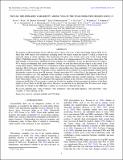| dc.contributor.author | Wolk, Scott J. | |
| dc.contributor.author | Poppenhaeger, Katja | |
| dc.contributor.author | Cody, A. M. | |
| dc.contributor.author | Rebull, L. M. | |
| dc.contributor.author | Forbrich, J. | |
| dc.contributor.author | Gutermuth, R. A. | |
| dc.contributor.author | Hillenbrand, L. A. | |
| dc.contributor.author | Plavchan, P. | |
| dc.contributor.author | Stauffer, J. R. | |
| dc.contributor.author | Covey, K. R. | |
| dc.contributor.author | Song, Inseok | |
| dc.contributor.author | Guenther, Hans Moritz | |
| dc.date.accessioned | 2016-01-05T00:47:33Z | |
| dc.date.available | 2016-01-05T00:47:33Z | |
| dc.date.issued | 2015-10 | |
| dc.date.submitted | 2015-03 | |
| dc.identifier.issn | 1538-3881 | |
| dc.identifier.issn | 0004-6256 | |
| dc.identifier.uri | http://hdl.handle.net/1721.1/100694 | |
| dc.description.abstract | We present an IR-monitoring survey with the Spitzer Space Telescope of the star-forming region GGD 12-15. More than 1000 objects were monitored, including about 350 objects within the central 5', which is found to be especially dense in cluster members. The monitoring took place over 38 days and is part of the Young Stellar Object VARiability project. The region was also the subject of a contemporaneous 67 ks Chandra observation. The field includes 119 previously identified pre-main sequence star candidates. X-rays are detected from 164 objects, 90 of which are identified with cluster members. Overall, we find that about half the objects in the central 5' are young stellar objects (YSOs) based on a combination of their spectral energy distribution, IR variability, and X-ray emission. Most of the stars with IR excess relative to a photosphere show large amplitude (>0.1 mag) mid-infrared (mid-IR) variability. There are 39 periodic sources, and all but one is found to be a cluster member. Almost half of the periodic sources do not show IR excesses. Overall, more than 85% of the Class I, flat spectrum, and Class II sources are found to vary. The amplitude of the variability is larger in more embedded YSOs. Most of the Class I/II objects exhibit redder colors in a fainter state, which is compatible with time-variable extinction. A few become bluer when fainter, which can be explained with significant changes in the structure of the inner disk. A search for changes in the IR due to X-ray events is carried out, but the low number of flares prevented an analysis of the direct impact of X-ray flares on the IR light curves. However, we find that X-ray detected Class II sources have longer timescales for change in the MIR than a similar set of non-X-ray detected Class IIs. | en_US |
| dc.description.sponsorship | Spitzer (Grant 1490851) | en_US |
| dc.language.iso | en_US | |
| dc.publisher | IOP Publishing | en_US |
| dc.relation.isversionof | http://dx.doi.org/10.1088/0004-6256/150/5/145 | en_US |
| dc.rights | Article is made available in accordance with the publisher's policy and may be subject to US copyright law. Please refer to the publisher's site for terms of use. | en_US |
| dc.source | IOP Publishing | en_US |
| dc.title | YSOVAR: MID-INFRARED VARIABILITY AMONG YSOs IN THE STAR FORMATION REGION GGD12-15 | en_US |
| dc.type | Article | en_US |
| dc.identifier.citation | Wolk, Scott J., H. Moritz Gunther, Katja Poppenhaeger, A. M. Cody, L. M. Rebull, J. Forbrich, R. A. Gutermuth, et al. “YSOVAR: MID-INFRARED VARIABILITY AMONG YSOs IN THE STAR FORMATION REGION GGD12-15.” The Astronomical Journal 150, no. 5 (October 12, 2015): 145. © 2015 The American Astronomical Society | en_US |
| dc.contributor.department | MIT Kavli Institute for Astrophysics and Space Research | en_US |
| dc.contributor.mitauthor | Guenther, Hans Moritz | en_US |
| dc.relation.journal | The Astronomical Journal | en_US |
| dc.eprint.version | Final published version | en_US |
| dc.type.uri | http://purl.org/eprint/type/JournalArticle | en_US |
| eprint.status | http://purl.org/eprint/status/PeerReviewed | en_US |
| dspace.orderedauthors | Wolk, Scott J.; Gunther, H. Moritz; Poppenhaeger, Katja; Cody, A. M.; Rebull, L. M.; Forbrich, J.; Gutermuth, R. A.; Hillenbrand, L. A.; Plavchan, P.; Stauffer, J. R.; Covey, K. R.; Song, Inseok | en_US |
| mit.license | PUBLISHER_POLICY | en_US |
| mit.metadata.status | Complete | |
